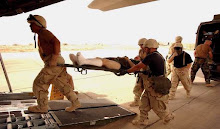By Steve Hammons
Will U.S. troops who have had serious war injuries find new help from ongoing research to regrow damaged human tissue?
According to an announcement March 23, 2009, the U.S. Defense Advanced Research Projects Agency (DARPA) has extended its contract with a Massachusetts biotechnology company for a research program on the regeneration of muscle tissue lost or damaged by traumatic injury.
DARPA’s long-range goal is to discover and optimize the natural regenerative abilities of the human body to heal war injuries experienced by U.S. troops, including injuries involving bone, muscle, nerves and other soft tissue.
What about people who have had limbs amputated? Could whole hands, arms and legs be regrown, similar to the way salamanders and starfish regrow limbs?
RESEARCHERS PURSUE DISCOVERIES
The company involved in the contract, CellThera, is part of the Bioengineering Institute (BEI) of the Worcester Polytechnic Institute (WPI).
A WPI press release notes that DARPA awarded CellThera a one-year $570,000 contract for research into regenerating mammalian muscle tissue. The contract could be extended for a second year. WPI will be a subcontractor for part of the program.
DARPA funded the first phase of the tissue regeneration program beginning in 2006 in a joint effort between CellThera, WPI and associates at Tulane University, the press release stated.
In that phase, the research team was successful in reprogramming mouse and human skin cells to behave more like stem cells, and more able to begin regrowing tissue.
In the next phase of the project, researchers will attempt to “reprogram and engineer cells to replace damaged skeletal muscle and to restore the normal function of that muscle,” according to the WPI press release.
Raymond Page, PhD, serves as principal investigator for WPI's part of the research. Page is an assistant professor in BEI and WPI's Department of Biology and Biotechnology.
In the next phase, George Pins, PhD, associate professor of biomedical engineering at WPI, joins efforts of the project. Pins developed cell-delivery strategies relevant to the program’s goals. Raymond Dunn, MD, will lead another team in the new research phase. Dunn is professor of surgery and cell biology at the University of Massachusetts Medical School and chief of plastic and reconstructive surgery at UMass Memorial Medical Center.
WOUNDED WARRIORS AND BIOLOGY
Many U.S. troops have sustained serious injuries in the wars in Iraq and Afghanistan. These wounds include traumatic and surgical amputations of legs and arms, burns, severe head and face trauma and other significant damage to body tissues.
Although improved body armor has prevented many deaths, as a result many troops survived with injuries so severe that they would have died in earlier wars.
Improvised explosive devices (IEDs) – roadside or vehicle-borne bombs – have been particularly deadly and damaging.
The DARPA-sponsored research may lead to new discoveries and medical applications that can help these seriously injured troops.
Currently, scientists understand much of the biology about how certain creatures regenerate limbs and other tissue. When salamanders and newts lose a limb, they create new "progenitor cells," also called "precursor cells." These cells gather at the site of the injury, forming a "blastema."
The blastema continue to grow and specialize into cells that form the nerves, bones, cartilage, muscles and skin to create a new limb.
For mammals, this ability typically occurs only in the fetal stage. Yet, new research and bioengineering activities have made progress in learning more about these processes.
Will the research soon progress to applications directly to humans? Depending on the progress made studying the genetic, cellular, chemical and other factors involved, human research could begin some day.
If DARPA-funded investigations into this field lead to success in regrowing selected human tissue, or even entire limbs and organs, people and children around the world with injuries, diseases and other significant medical problems could benefit in ways we can hardly imagine.
skip to main |
skip to sidebar

In the past 30 days, readers from approximately 40 countries or territories using about 20 languages visited the Joint Recon Study Group site.

To see more articles, scroll down the right-side column.

Steve Hammons

Articles from the Joint Recon Study Group site and Transcendent TV & Media site are included.
The Joint Reconnaissance Study Group is the San Diego-based, combined-service/agency, research-and-activities team in my novels "Mission Into Light" and sequel "Light's Hand." This site contains information of interest to the JRSG.
Home page: Joint Recon Study Group site
Readers from around the world visit this site.

In the past 30 days, readers from approximately 40 countries or territories using about 20 languages visited the Joint Recon Study Group site.
April 2021 threat alert: ‘Force protection’ for our troops now the responsibility of all Americans
First responders must deal with society’s problems, shortcomings, injustices every day
Could some UFOs be linked to Native American 'white stone canoe' legends, stories?
Wildland firefighter basic training available at community colleges, tech schools, training centers
‘Boomer remover’ coronavirus is bigger threat to WWII generation that saved the world
‘Black swan’ events that aren’t: Coronavirus, climate emergency, unidentified aerial phenonema
Reagan’s complete 1987 UN message on ‘alien threat’ overlooked: Grave danger here, now
Was Reagan briefed about UFOs and original ‘Day the Earth Stood Still’ movie?
My military draft lottery number was #165 during final Vietnam War years
“Keep On The Sunny Side,” by The Whites, from movie O Brother, Where Art Thou?”
Living along Ohio River for centuries, Native Shawnee called it ‘Kiskepila Sepe’ – ‘Eagle River’
Native American words around us: States, towns, rivers, lakes, terrain, plants, animals, military
Athens County, Ohio, was key spot when colonists, Redcoats fought Shawnee in 1774 battle
1787 Northwest Ordinance set course for Ohio, Indiana, Illinois, Michigan, Wisconsin, Minnesota
Smallpox-tainted blankets were 1763 bioweapon on northern Appalachian Mountains frontier
Diana Krall performs “Maybe You’ll Be There" live in Paris with Paris Symphony Orchestra 2001.
Books to read in 2021? Novels "Mission Into Light" and the sequel "Light's Hand"
Novel excerpt: Renew, prepare America with ‘Urgent Response Group’ for teens, young adults
Diana Krall performs “I Get Along” live in Paris with Paris Symphony Orchestra 2001.
Steve Tyrell sings “Give Me the Simple Life.”
Diana Krall performs “Love Letters” live in Paris with Paris Symphony Orchestra 2001.
Visit the article archives!

To see more articles, scroll down the right-side column.
Novel "Mission Into Light" overview on Amazon
Novel "Light's Hand" overview on Amazon
Adventures of the Joint Recon Study Group: Overview and synopses of activities and operations
Key chapter overviews: Points of interest in the novel "Mission Into Light"
Key chapter overviews: Points of interest in the novel "Light's Hand"
Multimedia rights available
English and foreign-language book rights, audio book and e-book rights for "Mission Into Light" and "Light's Hand" are available. Movie and TV rights are available.
I'm seeking agent representation for these works and rights.
Please contact Steve Hammons for more information at hammons55@gmail.com.
Feature film screenplay
I completed a feature film screenplay in 2006 based on “Mission Into Light” and “Light’s Hand” combining key elements of both novels.
The screenplay takes audiences into the adventures and discoveries of the Joint Recon Study Group and the relationships among team members, friends and associates as they explore leading-edge research and emerging transcendent developments.
I'm seeking agent representation for this screenplay.
.........................
I also wrote a TV series pilot script based on "Mission Into Light" and "Light's Hand" story. I'm seeking agent representation this script.
About the Author

Steve Hammons
About the Author
I was born and raised in southwestern Ohio near the Kentucky and Indiana borders, then went to college at Ohio University in the southeastern Appalachian region of the state near West Virginia.
I graduated with a dual major in communication (journalism focus) and health education (psychology focus) with a minor in pre-law.
Ohio U. is home to the respected Scripps College of Communication and E.W. Scripps School of Journalism.
I also completed two graduate-level courses in guidance counseling theory and method at Ohio U.'s College of Education, School of Applied Behavioral Sciences and Educational Leadership.
At the end of my undergraduate education at Ohio University, I moved to the beautiful American Southwest where I applied my education, continual training and and ongoing experience to related professional fields such as health care, journalism and special research areas.
My novels "Mission Into Light" and the sequel "Light’s Hand" are available in e-book and 6"x9" paperback from most online booksellers worldwide.
Readers review metaphysical-military-intelligence adventure novel ‘Mission Into Light’
My articles on DoD CultureReady blog, Defense Language and National Security Education Office
Transcendent TV & Media site
Past articles: Scroll down the right-side column for more articles.

Articles from the Joint Recon Study Group site and Transcendent TV & Media site are included.
New films, TV series, books tell stories of ‘Ohiyo’ River Appalachian mountain region
Hillbillies, pioneers and UFOs: Current major media projects explore southern Ohio
Well-known ‘Mothman’ case also about dedicated local journalist, Native history?
Film experts, fans celebrate rediscovery of Appalachian story ‘Spring Night Summer Night’
'Hillbilly' J.D. Vance, columnist Clarence Page find common ground in southwest Ohio roots
‘Phoenix lights’ UFO linked to multiple incidents around four-state Colorado Plateau?
UFOs, odd phenomena reported on perimeter of Colorado Plateau
Theory about 37th parallel and UFOs sparked book, TV shows, film concept
Sketchy dimensions: UFO investigations reveal need for caution, potential for beneficial discovery
Can UFO-acquired technologies help the U.S. economy?
Many Americans have Cherokee in the family tree
Americans with Cherokee roots can't rely on government bureaucracies to define them
Government-approved Cherokees don’t tell whole story?
Does tribal government politician speak for all Americans with Cherokee ancestry?
‘Official Cherokees’ disrespecting mixed-ethnicity Americans?
Could ‘Hillbilly Elegy’ author J.D. Vance have Appalachian Cherokee ancestry?
Journalism’s dilemma: Covering weird science
Movie ‘Sedona’ explores metaphysical mysteries, Nature’s beauty, human heart
Novel excerpt: Insight, understanding not always found in official reports, documents
Novel excerpt: From Sedona to Heaven – What is the dimension we call ‘Heaven?’
Interest grows in healthy aging, anti-aging, reverse-aging, transcendent aging
Analysis: Research company involved with UFOs opens up about activities
Startup company researching advanced tech, UFOs gives updates during Q&A
Leverage US resources to understand unknown objects encountered by Navy, defense expert says
US Navy UFO encounters: Space scientists speculate on ‘first contact’ with visitors
UFOs in the heartland: New movie, ‘Blue Book’ TV series set in southwestern Ohio
Year of UFOs, 1952, may play role in Disney movie ‘Tomorrowland’
UFO situation awareness: Phoenix conference hosts scientists, researchers, media, public
Appropriate security on UFOs probably 2-way street
Roswell was ET crash, says ex-CIA officer – what’s been going on since 1947?
Alleged briefing to Pres. Reagan: Original ‘Day the Earth Stood Still’ was UFO acclimation?
Beyond UFOs and extraterrestrials: Human consciousness
Journalism in media mix: New shows ‘Chasing UFOs,’ ‘Spacing Out’ help prepare public
Further UFO disclosure requires readiness, teamwork, education, intelligence
Disclosure, acclimation, security work together on UFO, ET challenges
Up to speed on UFOs and intelligent visitors? Revised ‘A.D. After Disclosure’ book released in May
Authors Zabel, Dolan explore adjusting to UFO truths in new book ‘A.D. After Disclosure’
Blog Archive
-
▼
2009
(34)
-
▼
March
(8)
- Transcendent warfare, transcendent power have pote...
- UFOs and public safety: Firefighter manual explain...
- Transcendent power has public safety applications
- Wounded troops: DARPA project to regrow human tiss...
- Joint competency in transcendent power needed
- Transcendent power is natural resource for ARPA-E
- Exploring and deploying soft power, transcendent p...
- Transcendent power reshapes hard power, soft power...
-
▼
March
(8)































































































































































































